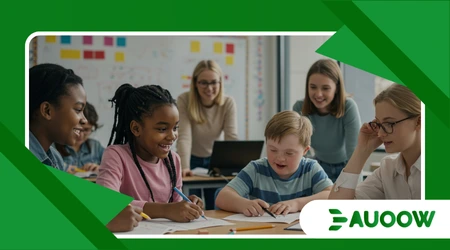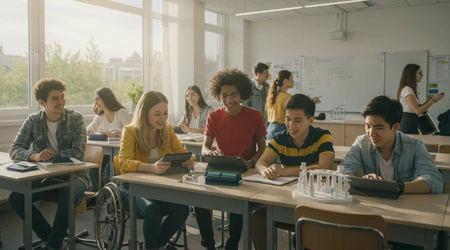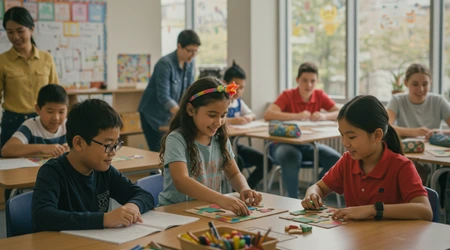Why Inclusive Education Is Key to Achieving the SDGs by 2030

The ambitious deadline of 2030 for the United Nations Sustainable Development Goals (SDGs) looms large. Among the 17 global targets, Goal 4, Quality Education, serves as a foundational pillar for success across the entire agenda.
However, meeting this objective, and others like poverty reduction (SDG 1) and reduced inequalities (SDG 10), hinges entirely on one critical strategy: recognizing that Inclusive Education Is Key to Achieving the SDGs by 2030. This is not merely an educational goal; it is a vital, cross-cutting development imperative.
Traditional educational models, often segregated or highly standardized, simply cannot address the complex, intersectional disadvantages faced by millions of children globally.
True inclusion where every learner, regardless of disability, gender, ethnicity, or socioeconomic status, learns together effectively is the necessary paradigm shift. We must move past seeing inclusion as a charitable act and embrace it as a strategic investment in human capital and global resilience.
As a journalist covering global development, the evidence is overwhelming: an integrated approach is the only approach that works.
SDG 4: Beyond Access to Quality
Goal 4 aims to “ensure inclusive and equitable quality education and promote lifelong learning opportunities for all.” The emphasis is clearly placed on both inclusiveness and quality. Achieving one without the other is a failure.
The Hidden Crisis of Exclusion
Current global estimates paint a grim picture. Millions of children remain out of school, many belonging to marginalized groups, including children with disabilities and those in conflict zones. Even those attending often lack quality access.
The 2024 UNESCO Global Education Monitoring (GEM) Report highlights a disturbing trend. It estimates that while school enrollment has increased globally, the proportion of students with disabilities in segregated settings remains disproportionately high in many low- and middle-income nations. This separation is a systemic barrier, directly undermining the spirit of SDG 4.
Furthermore, exclusionary practices are a costly drain on national economies. When individuals are denied quality, inclusive education, their potential contributions to the GDP remain untapped. This results in prolonged cycles of poverty and dependence, contradicting the aims of SDG 1 (No Poverty).
++ Sensory Play: Enhancing Learning for Students with Special Needs
Redefining Quality Through Inclusion
Quality education, in the context of the SDGs, is not just about test scores. It encompasses relevance, equitable learning outcomes, and safe, enabling environments. An inclusive classroom, by its very nature, demands differentiated instruction and flexible curricula.
This necessity forces educational systems to evolve, benefiting all learners. Teachers trained to support diverse needs often employ innovative pedagogical techniques that boost engagement for every student. This elevates the overall quality of education, ensuring every child, not just the majority, is prepared for future challenges.

The Economic Argument: Inclusion as Investment
The idea that Inclusive Education Is Key to Achieving the SDGs by 2030 rests heavily on economic logic. An educated population is productive, resilient, and contributes significantly to sustainable economic growth (SDG 8).
Also read: From Segregation to Inclusion: How Schools Are Evolving Worldwide
Breaking the Cycle of Poverty and Inequality
Exclusionary educational systems perpetuate intergenerational poverty. Children denied quality learning opportunities are much less likely to secure meaningful employment, trapping their families in a low-income cycle.
Example 1: The Disadvantage Multiplier. Consider a girl with a moderate visual impairment in a rural setting. Without an inclusive school providing adaptive materials and teacher support, she is far more likely to drop out.
This drop-out reinforces gender inequality (SDG 5) and economic disparity (SDG 10). Conversely, providing a simple screen reader and specialized training turns her into a productive, tax-paying citizen. Her inclusive schooling yields exponential returns.
Moreover, inclusive education addresses the root cause of inequality. By teaching all students to value diversity and accommodate differences from a young age, it actively reduces discrimination and social fragmentation later in life, supporting SDG 10 (Reduced Inequalities). It’s a societal inoculation against intolerance.
Read more: Pilots of inclusive education models like Maine’s new program
The Diversity Dividend
An inclusive workforce comprising individuals with diverse abilities and backgrounds is proven to be more innovative and resilient. The skills developed through managing classroom diversity empathy, flexibility, and collaborative problem-solving are precisely the “soft skills” required in the modern global economy.
The World Bank’s 2023 report on Disability Inclusion highlighted that societies that fully integrate people with disabilities into education and employment can experience an increase in GDP of up to 7%.
This “Diversity Dividend” provides a compelling financial incentive for every nation to ensure that Inclusive Education Is Key to Achieving the SDGs by 2030. Ignoring this potential represents a massive, voluntary loss of human capital.
The Interconnected Web: Inclusion and Environmental Sustainability

The impact of inclusive education is not confined to social goals. It is a powerful, indirect driver for environmental sustainability (SDG 13).
Informed Citizenship and Climate Action
Solving complex global issues like climate change requires universal, critical thinking, and collective action. Only a truly educated and critically engaged populace can understand the scientific complexities and implement the necessary behavioral changes.
When educational access is inequitable, the burden of environmental ignorance falls heaviest on marginalized communities, who are often the first to suffer the effects of climate change.
Inclusive education ensures that all future citizens including those who have historically been excluded from policymaking are equipped to engage in climate mitigation and adaptation strategies. It transforms passive victims into active agents of change, reinforcing SDG 13 (Climate Action).
Analogia: Excluding certain groups from education is like building a dam with only half the necessary engineers. The structure is inherently flawed and prone to failure when faced with stress.
Only by utilizing the full talent pool achieved through inclusion can we design the resilient, comprehensive solutions required for sustainability.
Fostering Sustainable Communities (SDG 11)
Inclusive schools often become hubs for their entire community, promoting sustainable practices. When schools are designed to be accessible and cater to local needs, they teach practical skills related to resource management and local food systems. This localized knowledge transfer strengthens communities.
An inclusive school might partner with local organizations to make its campus zero-waste, demonstrating practical sustainability that engages students of all abilities in the project.
This participatory learning model ensures the lessons translate directly into community action, which is vital for achieving SDG 11 (Sustainable Cities and Communities).
The Policy Imperative: From Commitment to Action
The global community has the commitment; the challenge now lies in operationalizing it. To guarantee that Inclusive Education Is Key to Achieving the SDGs by 2030, policy must align with practice.
| SDG Goal | Link to Inclusive Education | Concrete Outcome by 2030 |
| SDG 1 (No Poverty) | Breaks the intergenerational cycle of exclusion and deprivation. | Increased participation of marginalized groups in the formal economy. |
| SDG 4 (Quality Education) | Ensures differentiated, relevant learning for all students. | 100% completion rates for primary and secondary education for all demographic groups. |
| SDG 10 (Reduced Inequalities) | Fosters social cohesion and reduces discrimination from a young age. | Narrowed income gaps between groups previously excluded from education. |
| SDG 17 (Partnerships) | Requires multisectoral collaboration (health, transport, community). | Strengthened national data systems to track inclusive educational outcomes. |
The required policy shifts involve redirecting funding from segregated institutions to general education schools and implementing rigorous teacher training in Universal Design for Learning (UDL).
This UDL approach anticipates diversity from the outset, eliminating the need for costly retrofitting later.
We are five years from the finish line. Can we afford to waste the potential of millions of people by clinging to outdated, exclusionary education models?
The evidence is conclusive: prioritizing Inclusive Education Is Key to Achieving the SDGs by 2030. The time for half-measures is over. Let us make the final push count.
Frequently Asked Questions (FAQ)
Q: Isn’t inclusive education too expensive for low-income countries?
A: The reality is that segregation is often more expensive long-term. Maintaining separate schools, specialized transportation, and parallel administrative systems is inefficient and costly.
While initial investment is required for training and infrastructure upgrades (like ramps and accessible washrooms), the long-term economic returns from increased GDP contribution and reduced welfare dependency make inclusive education a fiscally responsible investment.
Q: Does inclusive education lower the educational standards for other students?
A: No, that is a common misconception debunked by decades of research. Inclusive classrooms, when properly supported with trained teachers and resources, often lead to improved learning outcomes for all students.
The focus on differentiated instruction, personalized learning, and cooperative learning strategies benefits the entire classroom dynamic. Students learn empathy and social skills alongside academic subjects.
Q: What is the biggest barrier to implementing inclusive education globally?
A: The biggest barrier isn’t funding or infrastructure; it is attitude and political will. Overcoming deep-seated societal biases against disability, gender, or ethnic minorities requires strong government leadership and comprehensive teacher training programs.
Shifting from a mindset of “fixing the child” to “fixing the system” is the most challenging, yet crucial, step to realizing that Inclusive Education Is Key to Achieving the SDGs by 2030.
